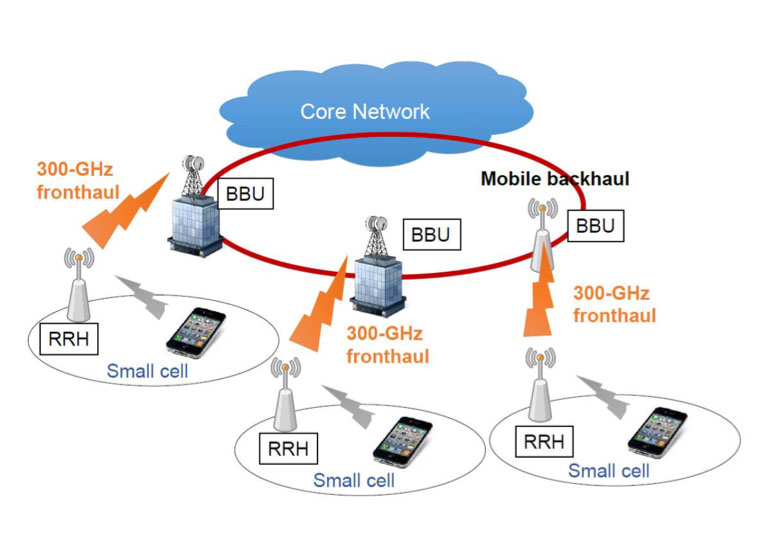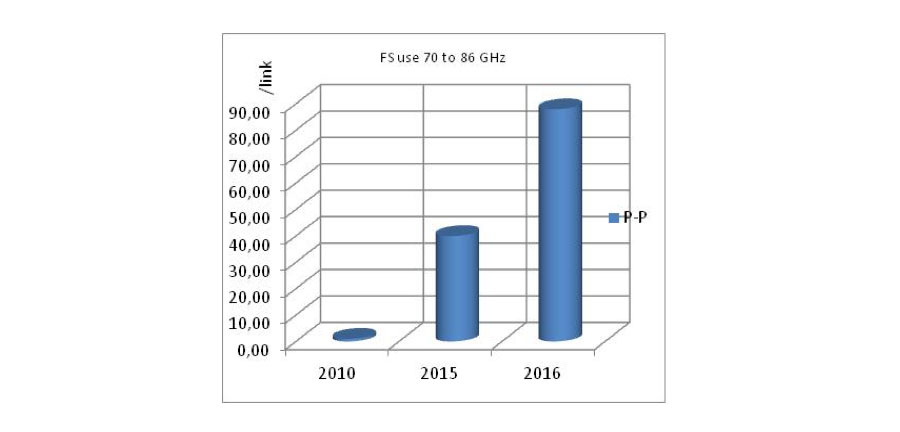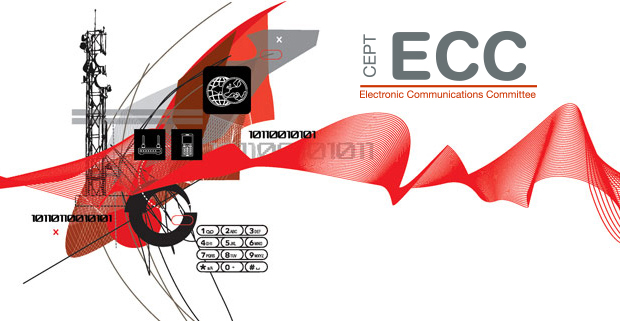- ECC investigates the possibility of using digital equipment in maritime VHF voice communications
- STIR/SHAKEN – Europe watches with interest as the United States and Canada roll out a solution for authenticating calling line identification
- Quo Vadis? Fixed Service evolves towards more efficient spectrum use
Quo Vadis? Fixed Service evolves towards more efficient spectrum use
In the quest for more capacity, greater flexibility and better performance, fixed wireless systems will be one of the main backhaul choices for mobile and transport networks.
Far from the spotlight of well-known areas in wireless communications such as 5G and satellite, developments in the fixed service world can often go unnoticed – even when a fundamental paradigm shift is underway.
What is fixed service?
Fixed service is an integral component in the overall telecommunications infrastructure. Fixed wireless systems are used for access and transport networks such as for trunking, multi-hop and long-haul connections. They are mainly used for mobile backhaul networks, for fixed wireless access networks and for temporary networks, such as disaster response and recovery links.
Typical users of the fixed service include telecom operators, corporate and private users. Telecom operators use it in mobile network infrastructure and fixed/mobile network backbone links, while businesses use it for private data networks and connection of remote premises, etc. Customers, meanwhile, use it for access to PSTN or other wireless broadband networks.
Fixed service in backhaul operations
To meet the ever-increasing demand for bandwidth-hungry applications, both wired and wireless solutions need to be considered as transport backhaul options for networks. Key technical requirements include the ability to handle more capacity, data throughput and to address low latency traffic. Others include overall cost effectiveness and ease of installation, as a large number of new small cell deployments are expected to address the demand for mobile broadband growth.
An evolved C-RAN-based architecture is emerging as a popular choice to deliver future 5G services. This architecture consists of three primary components — a centralised baseband unit (BBU) pool, remote radio unit (RRU) networks and a transport network. This approach could lead to a different functional split in the radio access network compared to traditional mobile networks. As a result, the radio remote unit (RRH) will no longer be located at the same site as the base band unit (BBU). In this context, the backhaul is the link connection between the base station and higher-level network elements, whereas the fronthaul is the link connection between the BBU and RRH.

Figure 1 - Fronthaul and backhaul operation (Source: Report ITU-R F.2416-0)
According to some projections, future backhaul capacity requirements will range between 5 and 20 Gbps per base station depending on factors such as the cell type (for example, macro/small cell) and site type (for example, dense urban, suburban). Moreover, with the evolution of technologies and the availability of new spectrum, between 10 Gbps and 100 Gbps will be required to support fronthaul applications.
It should be noted that the term "X-haul" is also commonly employed in the context of development of transport network architectures. X-haul refers to the common flexible transport solution for future 5G networks, aimed at integrating the fronthaul and backhaul networks. It combines all their wired and wireless technologies in a common packet-based transport network under an SDN-based (software defined networks) and NFV-enabled (network functions virtualisation) common control framework.
Today, many industry analysts point out that microwave links are the prevailing option compared to other technologies and they currently serve on average more than 50% of macro and small cell sites. This figure does vary in different regions around the world. In order to cope with capacities reaching multigigabit/s for fixed wireless backhaul systems, several techniques have been introduced in the fixed service frequency bands, from 6 to 80 GHz. One such technique is adaptive modulation, which allows for a dynamic smooth switch between different modulation formats, increasing or decreasing the payload capacity accordingly.
Higher order modulation equipment – as high as 2048 QAM – is available. Adaptive modulation systems also have built-in automatic transmit power control functionality (see ECC Report 198), which enables transmitter power to be reduced for higher complexity formats requiring higher linearity.
CEPT has also performed studies to examine the impact of current asymmetry trends in the access and backhaul networks. ECC Report 211 primarily focuses on the use of asymmetric channel widths within the traditional bidirectional link allocation.
It should also be noted that whilst the presence of asymmetry in the access network is agreed, the degree of this asymmetry differs from operator to operator based on the services offered.
One other prominent technology, MIMO (Multiple Input Multiple Output), has been considered for fixed service, as described in ECC Report 258. The Report shows that Line-of-Sight (LoS) MIMO in point-to-point fixed service links is an efficient way of increasing capacity or availability without using more spectrum. The Report also provides a technical comparison between LoS MIMO links and a typical traditional Single Input Single Output (SISO) link.
Frequency bands for fixed service
In principle, all frequency bands available for fixed service could be used for transport networks, noting that those bands need to be assessed against technical characteristics such as appropriate transmission capacities, RF channel spacing, RF channel size availability and typical link lengths. The following picture illustrates the various frequency bands harmonised in CEPT, including the higher frequency bands 92-114.25 GHz (referred to as "W-Band") and 130-174.8 GHz (referred to as "D-Band") where CEPT harmonisation measures were developed more recently, in 2018.

Figure 2 - FS frequency bands for harmonised channel arrangement
Although usage varies among countries in Europe, the current trends in the fixed service marketplace are for an ever-increasing provision of high bandwidth capacity for mobile network infrastructure. These very high capacity links are able to provide a viable alternative to deploying fibre optic cable in rural and in high density urban areas. Some of the frequency bands are of strategic importance and have already started to show rapid growth in terms of the number of links (13 GHz, 15 GHz, 18 GHz, 23 GHz, 38 GHz). Figure 3 below shows the rapid adoption and implementation of these traditional frequency bands for the fixed service.

Figure 3 - Active links in 2017 (P-P only) for the FS bands (between 13 GHz and 38 GHz) (Source: ECC Report 173, Fixed Service in Europe Current use and future trends post 2016)
Moreover, according to the data gathered in ECC Report 173, there is a clear trend towards more intensive use of higher frequency bands such as in 71-76 GHz / 81-86 GHz (also known as the "E-Band") as seen in figure 4 below.

Figure 4 - Trends for the use of FS in the E-band (Source: ECC Report 173)
From a general perspective, the use of fixed service bands can be divided into three broad categories, each fulfilling specific future traffic requirements based on their distance ranges: low frequency bands, mid-range frequency bands and high frequency bands.

Figure 5 - Trends for the use of FS in the E-band (Source: ETSI White Paper No. 25, Microwave and Millimetre-wave for 5G Transport)
Given the new requirements for fixed link applications for covering the demands of multigigabit/s 5G transport networks, ECC Report 282 examined the frequency bands above 90 GHz. In particular, the use of the W-Band and the D-Band for very high capacity short range links have been examined. This Report studied, amongst other things, the propagation characteristics for each band, applications, use cases and technology specific issues. The Report concluded that the W-Band and D-Band have high potential to fulfil the future demands of radio links and networks and are deemed to be suitable for the capacity, latency and availability requirements for 5G following consideration of the densification of sites and deployment flexibility.
CEPT also considers that both frequency bands provide an opportunity to cope with the increasing market demand for very high bandwidth access, in particular for internet-based applications and backhaul/X-haul for next generation mobile networks. Fixed radio links may be deployed much more quickly, and in certain cases are more cost efficient than wired networks, for example, when small cells are deployed at street level on urban utilities infrastructure. As such, these bands provide sufficient capacity for terrestrial fixed links to compete or complement fibre optic-based access networks.
The harmonised channel/block arrangements for the D-Band and the W-Band are contained in ECC Recommendations (18)01 and (18)02. Both Recommendations provide the administrations wishing to use block-based assignment the necessary flexibility to derive blocks by channel aggregation. They can do this in either paired or unpaired spectrum in multiples of 250 MHz. The Recommendations also allow for flexible channel use in symmetric or asymmetric go/return inside the blocks, for example, in time division duplex, full duplex or flexible frequency division duplex.
Additionally, with a view to supporting wider channel bandwidths in the traditional fixed frequency bands from 11 to 38 GHz, CEPT reviewed the channel arrangements in 2019. It agreed on updates to the relevant ECC Recommendations (listed in table 1 below) so that wider channel bandwidths are allowed in those frequency bands. Up to 112 MHz or 220/224 MHz will be allowed, doubling the previous maximum size available.
| ECC Recommendation | Title |
|---|---|
| ERC/REC 12-03 | ERC Recommendation of 1994 on harmonised radio frequency channel arrangements for digital terrestrial fixed systems operating in the band 17.7 GHz to 19.7 GHz, amended on 29 May 2019 |
| ERC/REC 12-06 | ERC Recommendation of 1996 on preferred channel arrangements for fixed service systems operating in the frequency band 10.7-11.7 GHz, amended on 5 February 2010 and on 29 May 2019 |
| ERC/REC/(01)02 | ERC Recommendation of 2001 on preferred channel arrangement for fixed service systems operating in the frequency band 31.8-33.4 GHz, revised on 5 February 2010 and amended on 29 May 2019 |
| T/R 12-01 | Recommendation T/R of 1991 on preferred channel arrangements for fixed service systems operating in the frequency band 37.0-39.5 GHz, latest revised on 5 February 2010 and amended on 29 May 2019 |
| T/R 13-02 | Recommendation T/R of 1993 on preferred channel arrangements for fixed service systems in the frequency range 22.0-29.5 GHz, revised on 15 May 2010 and amended on 29 May 2019 |
Table 1 - Updated (in 2019) ECC Recommendations to allow wider channel bandwidths
As a follow-up action resulting from the update of the above-mentioned Recommendations, a study has been carried out in CEPT to analyse the possible interference (for both in-band (sharing) and out-of-band (compatibility) of using a single wide channel instead of two adjacent channels with the same total bandwidth in. The findings of the study – draft ECC Report 319, which is subject to public consultation – indicate that, based on worst case scenarios, such problems are negligible.
There are some promising technological developments related to Band and Carrier Aggregation, which have the potential to bring enormous increases in performance, while leaving a high degree of flexibility in the design of the backhaul/X-haul solution. So far, focus has been on bonding carriers within the same frequency band. The new concept behind Band and Carrier Aggregation is to build on a point-to-point connection, using two or more "carriers", which may even belong to different frequency bands and may have different channel sizes. The payload that could be obtained is equivalent to a single carrier connection using a wider channel and with several adaptive modulation steps. This would allow for different steps in terms of capacity or availability. More detailed discussion can be found in draft ECC Report 320, which is also subject to public consultation.
State of play
Mobile backhaul requirements will continue to drive demand for fixed wireless links particularly given the denser networks anticipated for 5G and the higher data rates they will bring.
In recent years, fixed wireless systems technology developments have enabled the delivery of multigigabit/s capacity in a quick and cost-efficient manner. In the quest for more capacity, greater flexibility, better performance and efficient spectrum use, technological innovation will continue to develop to meet market needs. In some cases, cutting-edge technologies have already been implemented for higher-order modulation, wider channels, higher frequency bands, adaptive modulation and Band and Carrier Aggregation.
Thanks to this ongoing innovation, fixed wireless systems will continue to be one of the main backhaul/X-haul transport means of choice for mobile networks. They will play an increasingly significant role in supporting the expansion of advanced mobile broadband as the widescale deployment of 5G continues.
Jaime Afonso
Spectrum Expert
European Communications Office



